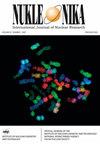电子束和混合电子束湿式洗涤法去除船用柴油机尾气中的有机污染物
IF 0.3
4区 物理与天体物理
Q4 CHEMISTRY, INORGANIC & NUCLEAR
引用次数: 1
摘要
摘要采用电子束和混合电子束湿法洗涤两种工艺对船舶排放物中的有机污染物进行了去除研究。采用移动式加速装置处理里加船厂拖船排放的4915Nm3/h烟气。将含有36.8mM NaClO2氧化剂的3m3体积的海水用作湿式洗涤器溶液。有机污染物,主要是挥发性有机污染物(VOCs),分别在辐照容器前后和湿式洗涤器单元后的三个不同采样点采集。用玻璃取样瓶、泰迪熊袋、椰子壳木炭(CSC)吸附剂和XAD-2吸附剂收集。CH3OH和CH3OH/CH2Cl2(1:1)分别用于从CSC和XAD-2吸附剂中提取挥发性有机物。使用注射器过滤器来获得无固体的提取溶液。使用微型提取器在连续吹制高纯度Ar的条件下对其进行浓缩。使用气相色谱-质谱(GC-MS)进行分析。已鉴定的有机化合物为:脂肪烃(十二烷C12H26至二十烷C20H42)、芳烃(甲苯)、酯(C3H7COOCH3,(C4H9OCO)2C6H4)、硝基化合物(C3H5NO3,C4H7NO2)和酸(C7H15COOH)。在4.2 kGy的EB辐射后,从废气中去除了约50–100%的脂肪烃、83%的甲苯和7.5%的(C4H9OCO)2C6H4,在EB混合湿式洗涤器工艺后,去除了包括硝基化合物在内的大多数有机化合物。气相中只发现微量的甲苯、十六烷、十八烷和邻苯二甲酸二丁酯。本文章由计算机程序翻译,如有差异,请以英文原文为准。
Organic pollutant removal from marine diesel engine off-gases under electron beam and hybrid electron beam and wet scrubbing process
Abstract The removal of organic pollutants from ship emission was studied using two processes namely electron beam (EB) and hybrid EB with wet scrubbing process. A mobile accelerator unit was used to treat 4915 Nm3/h of flue gas emitted from a tugboat in Riga Shipyard. A volume of 3 m3 seawater containing 36.8 mM of NaClO2 oxidant was used as a wet scrubber solution. Organic pollutants, mainly volatile organic pollutants (VOCs), were collected at three different sampling points, before and after irradiation vessels, and after wet-scrubber unit, respectively. They were collected with glass sampling bottles, tedlar bags, Coconut Shell Charcoal (CSC) sorbents and XAD-2 sorbents. CH3OH and CH3OH/CH2Cl2 (1:1) were used to extract VOCs from CSC and XAD-2 sorbents, respectively. Syringe filters were used to obtain the solid-free extraction solutions. They were concentrated using a micro-extractor under continuously blowing high-purity Ar. A gas chromatography–mass spectrometry (GC-MS) was used for analysis. The identified organic compounds were: aliphatic hydrocarbons (dodecane C12H26 to eicosane C20H42), aromatic hydrocarbon (toluene), esters (C3H7COOCH3, (C4H9OCO)2C6H4), nitro compounds (C3H5NO3, C4H7NO2) and acid (C7H15COOH). After 4.2 kGy EB irradiation, around 50–100% aliphatic hydrocarbons, 83% toluene and 7.5% (C4H9OCO)2C6H4 were removed from the off-gases, and after EB hybrid wet-scrubber process, most organic compounds including nitro compounds were removed. Only trace amount of toluene, hexadecane, octadecane and dibutyl phthalate were found to be present in the gas phase.
求助全文
通过发布文献求助,成功后即可免费获取论文全文。
去求助
来源期刊

Nukleonika
物理-无机化学与核化学
CiteScore
2.00
自引率
0.00%
发文量
5
审稿时长
4-8 weeks
期刊介绍:
"Nukleonika" is an international peer-reviewed, scientific journal publishing original top quality papers on fundamental, experimental, applied and theoretical aspects of nuclear sciences.
The fields of research include:
radiochemistry, radiation measurements, application of radionuclides in various branches of science and technology, chemistry of f-block elements, radiation chemistry, radiation physics, activation analysis, nuclear medicine, radiobiology, radiation safety, nuclear industrial electronics, environmental protection, radioactive wastes, nuclear technologies in material and process engineering, radioisotope diagnostic methods of engineering objects, nuclear physics, nuclear reactors and nuclear power, reactor physics, nuclear safety, fuel cycle, reactor calculations, nuclear chemical engineering, nuclear fusion, plasma physics etc.
 求助内容:
求助内容: 应助结果提醒方式:
应助结果提醒方式:


